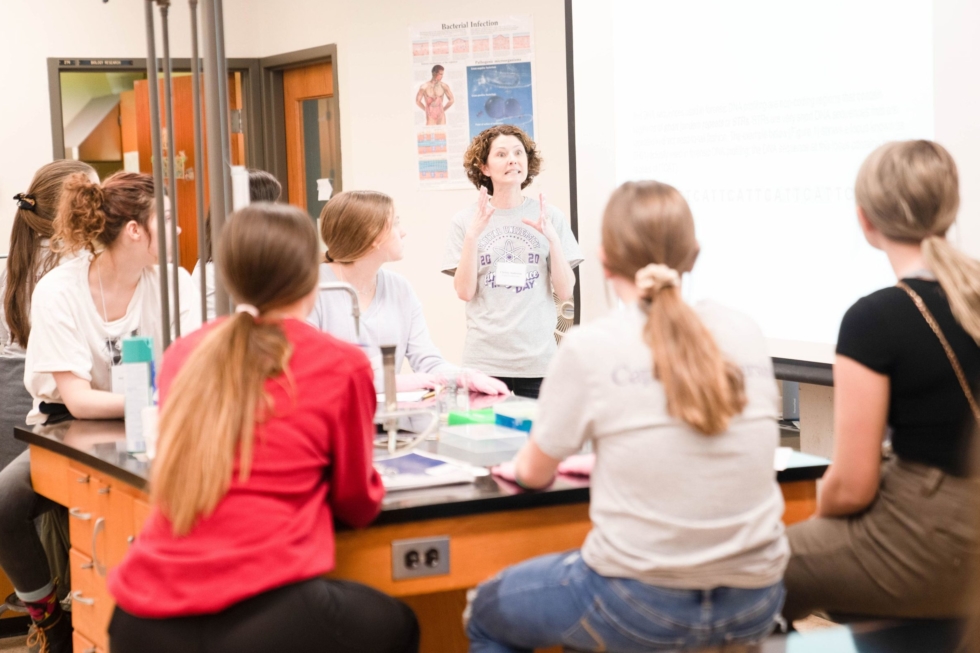It seemed like a curious stroke of irony that on February 24, 2020, I learned Katherine Johnson had passed away. Katherine was an African-American mathematician whose calculations were critical for NASA to successfully achieve manned spaceflight. Ironically, her death came on the same day as Capital University Girls in Science Day. This caused me to reflect on my own path as a woman in STEM.
I chose to become a high school science teacher because the laboratory activities kept me engaged and motivated my learning. Science, and chemistry especially, held something special for me. It was one of the first classes where I was out of my seat doing laboratory activities. I experienced success in those hands-on labs with balances, mixing chemicals, and using a Bunsen Burner. Chemistry also had the boon of having mathematics in it, where I could calculate how many moles were in a substance. I later realized from my undergraduate classes that I was a kinesthetic learner who learned best when my hands were busy.

As a young science teacher, I had many goals for myself and my classroom. I wanted it to be a safe space where all students, not just the “popular, put-together” ones would feel comfortable with themselves and science. I wanted them to feel free to ask questions, discuss/debate, and to have an incorrect answer without fear of retribution from me or their classmates. I wanted them to know that despite being seen as nerdy, smart, dorky, fat, skinny, stupid, ‘uncool,’ and above all, very self-conscious about who they were, they, too, could be successful in STEM. STEM was for regular people like us, humorous, humble, and compassionate.
It was about halfway through my second year of teaching upper-level science classes in a rural setting that I noticed the lack of girls signing up for my chemistry and physics courses. Wanting to both encourage my students and help my enrollment numbers, I asked freshman physical science students, and especially females, why they did not enroll in my courses, and their responses were “I’m not good at science” or “That’s too hard.” Around this time, a large university was having an event for middle school girls that would allow each girl to participate in hands-on science labs. Miraculously, I received funding and took a group of rural middle school girls to attend, knowing we could participate this year, but the funding would be unavailable to go next year.


Continuing to provide these hands-on experiences for middle grade students was my focus for the next year. Therefore, I wrote and received grant funding for equipment, gathered female science teachers, college instructors, and engineers together to facilitate a total of four hands-on workshops that each middle school girl could attend for “Girls in Science Day 2008.” It was held at a local school during their spring break, so that classrooms, the cafeteria, and the auditorium were available. That first year, 75 girls from six county schools attended. After four workshops and lunch, there was a panel discussion and the workshop facilitators discussed their interest in science, education, balancing work and family, and other questions from the students. The day was a resounding success and has since occurred each year.
From that first success, the mission that would become my vocational focus was clear: I would strive to give all females, but especially those who didn’t have as many resources as I had had, the access to successful science experiences, and the encouragement that they, too, can have a STEM career if they choose.
Capital University has welcomed my work, and February 24, 2020, was the third Capital University Girls in Science Day since my arrival. Many schools want to attend. My goal is to increase the frequency of this event so more students may attend. I have my STEM education students taking mobile science opportunities to local schools, and developing a Saturday science program, too.
Capital University's Girls in Science Day is open to any middle school students, regardless of gender, gender identity, or gender expression, who are interested in learning about women in STEM and STEM careers.

Perhaps Katherine Johnson never dreamed that she would be a role model to women and minorities everywhere, but I question whether that is what she set out to do in the first place. When she was asked for advice for NASA employees who would follow in her footsteps, she said “Like what you do and then you will do your best.”
The millions of unknown STEM teachers who like what they do are the ones who are developing new role models to continue Katherine Johnson’s legacy.
